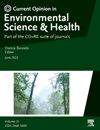Tailings dam failures in Brazil: River contamination, ecosystem recovery, and institutional responses to the Mariana and Brumadinho disasters
IF 6.6
Q1 ENVIRONMENTAL SCIENCES
Current Opinion in Environmental Science and Health
Pub Date : 2025-08-05
DOI:10.1016/j.coesh.2025.100654
引用次数: 0
Abstract
Mine tailings are wastes from ore extraction and processing, which are frequently stored in hillslopes behind earth dams. Unfortunately, tailings dams have collapsed in a number of places worldwide, literally dumping the waste into nearby rivers as metal-rich debris and mud. The environmental impact of these accidents is systemic and often severe and long-lasting. This study reviewed recent cases from Brazil (the Mariana accident that affected the Doce River and the Brumadinho accident that affected the Paraopeba River), highlighting the impact of large tailings dams' failures on river water quality and implications derived therefrom. The review showed how the Mariana failure affected the entire course of the Doce River, even impacting the estuarine ecosystem for a decade so far; and how physical barriers such as the Igarapé weir helped delaying the propagation of contamination in the Paraopeba River. Invariably, the contamination of river water was characterized by concentrations of metals (e.g. iron, manganese) and turbidity above the legal thresholds and far exceeding the levels observed before the accidents, which in the Brumadinho case, led to the suspension of drinking water supply to the metropolitan region of Belo Horizonte, affecting 2 million people. Besides, bioavailable phases of metals have accumulated in various trophic levels across the food web, threatening human health. The role of storm events in the exacerbation of water quality degradation and the potential impact of floods on the health of riparian forests were also recognized, because contaminated sediments were resuspended during those events and riverbanks were inundated in the sequel. Moreover, contaminated surface water flowing from urban, industrial, and pastureland areas masked the water quality degradation of Paraopeba River caused by the tailings dams' failures, because this water also contained metals and other toxic elements. On the other hand, inflows of sediments and water from tributary rivers helped dilute the contamination in the main watercourses. The time required to bring the river water quality back to safe levels was assessed in some studies, which pointed to 6–8 years in the Brumadinho case and provided no clear timespan for the Mariana case. Dredging of mine waste from the impacted areas was said to accelerate the recovery of Paraopeba river. The reviewed articles suggested some institutional responses, both systemic and specific to tailings dam accidents. The systemic measures comprised reforestation and implementation of best management practices to prevent water erosion and contaminant transport across the river basins, coupled with integration of accountable water quality monitoring in landscape management plans and policies. The specific measures were mostly related with prevention through the design of promptly implementable emergency action plans, coupled with policies capable of making the mining companies pay the recovery costs in a reasonable timeframe, where the affected population has a voice and participates in the compensation process. Overall, the reviewed papers shed light over key issues related to the impacts of large tailings dam accidents on riverine systems in general, in spite of describing two specific cases, leveraging useful insights to the authorities in charge of water security in emergency scenarios.
巴西尾矿坝失败:河流污染,生态系统恢复,以及对马里亚纳和布鲁马迪尼奥灾难的制度反应
矿山尾矿是矿石开采和加工过程中产生的废物,通常储存在土坝后面的山坡上。不幸的是,世界上许多地方的尾矿坝已经坍塌,将富含金属的废料和泥浆倾倒到附近的河流中。这些事故对环境的影响是系统性的,往往是严重和持久的。本研究回顾了巴西最近的案例(影响多塞河的马里亚纳事故和影响帕拉奥佩巴河的布鲁马迪尼奥事故),强调了大型尾矿坝的失败对河流水质的影响及其产生的影响。该审查显示了马里亚纳的失败是如何影响多塞河的整个河道的,甚至影响到河口生态系统至今已有十年之久;以及诸如igarapevoir之类的物理屏障如何帮助延缓了Paraopeba河污染的传播。河水污染的特点总是金属(如铁、锰)浓度和浑浊度超过法定阈值,远远超过事故发生前的水平,在布鲁马迪尼奥事件中,事故导致贝洛奥里藏特大都市地区的饮用水供应中断,影响到200万人。此外,金属的生物可利用相在整个食物网的各个营养水平上积累,威胁着人类的健康。还认识到风暴事件在加剧水质退化中的作用以及洪水对河岸森林健康的潜在影响,因为在这些事件期间污染的沉积物被重新悬浮,随后河岸被淹没。此外,从城市、工业和牧场流出的受污染的地表水掩盖了尾矿坝失效造成的Paraopeba河水质退化,因为这些水还含有金属和其他有毒元素。另一方面,来自支流河流的沉积物和水的流入有助于稀释主要水道中的污染。一些研究评估了将河流水质恢复到安全水平所需的时间,在布鲁马迪尼奥案例中指出需要6-8年,而在马里亚纳案例中没有提供明确的时间范围。据说,从受影响地区疏浚矿山废物可以加速Paraopeba河的恢复。综述的文章对尾矿坝事故提出了一些制度性的和具体的应对措施。系统性措施包括重新造林和实施最佳管理措施,以防止水侵蚀和污染物在流域之间的运输,同时将负责任的水质监测纳入景观管理计划和政策。具体措施大多与预防有关,通过制定可迅速执行的紧急行动计划,加上能够使矿业公司在合理的时间范围内支付恢复费用的政策,在这种情况下,受影响的人口有发言权并参与赔偿过程。总体而言,经过审查的论文揭示了与大型尾矿坝事故对河流系统的总体影响相关的关键问题,尽管描述了两个具体案例,为紧急情况下负责水安全的当局提供了有用的见解。
本文章由计算机程序翻译,如有差异,请以英文原文为准。
求助全文
约1分钟内获得全文
求助全文
来源期刊

Current Opinion in Environmental Science and Health
Medicine-Public Health, Environmental and Occupational Health
CiteScore
14.90
自引率
0.00%
发文量
92
审稿时长
114 days
 求助内容:
求助内容: 应助结果提醒方式:
应助结果提醒方式:


